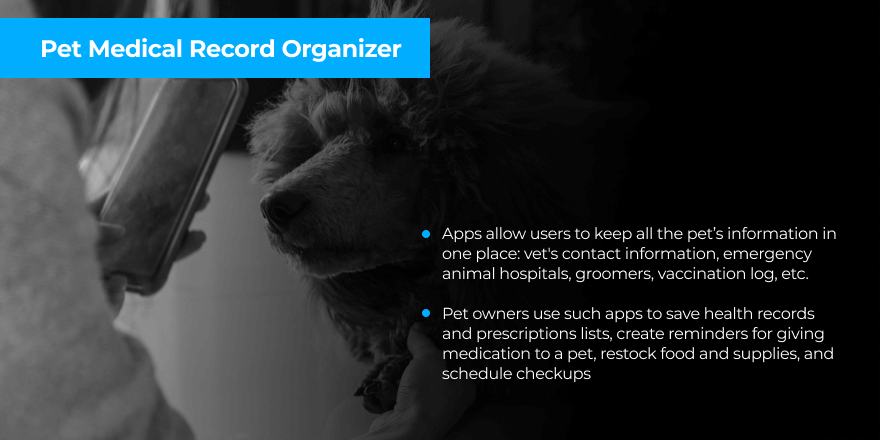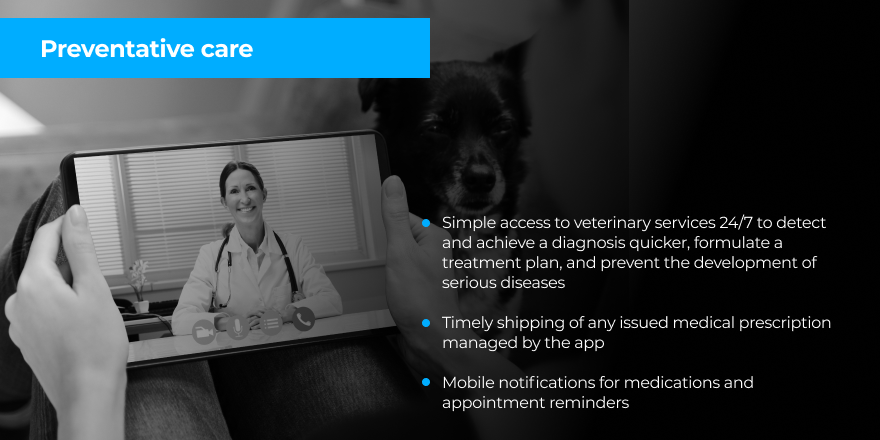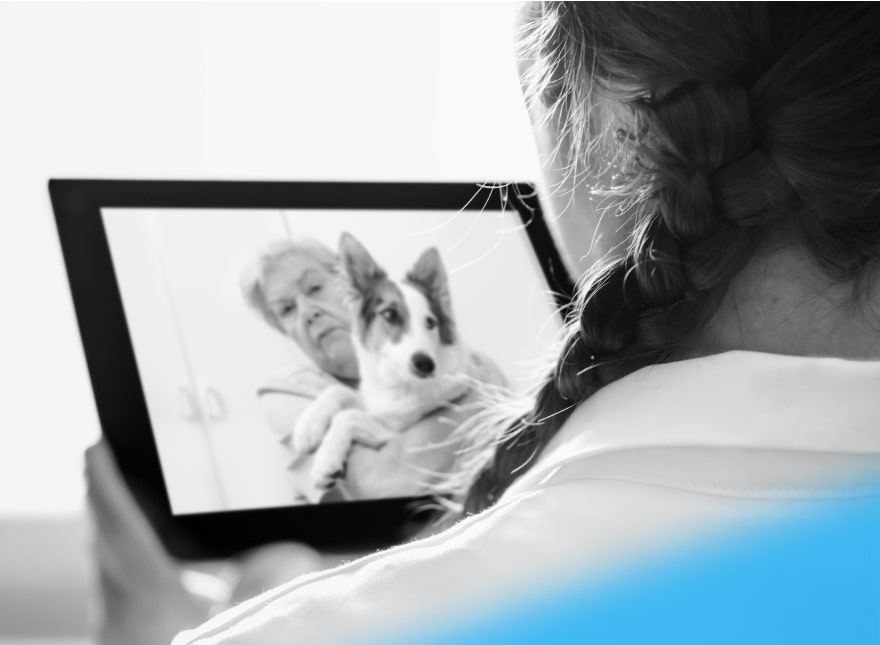Pet Care in the Age of Telehealth (Part II)

Televet services gained wide recognition in 2020 due to the COVID-19 outbreak. Pet owners have moved towards online vet tools to reduce spread of coronavirus in both pets and humans. Online veterinary services are valued for their availability, high quality level, and ease of use.
Table of Contents
With this context in mind, virtual vet startups are starting to impact pet care and are raking in funding.
Televet Market: How Much Money Are We Talking About?
Televet services have been around since the advent of online video conferencing technology. Back in 2020, the technology market linked to this sector was already worth $92 million. And according to Grand View Research, the market size may reach $417 million by 2028, demonstrating 20% annual growth.
In 2020, the largest share—37%—of the global pet televet market was in North America.
The second largest market is the APAC region. It boasts 21% annual growth—more than any other region in the world.
Learn more about the current state of affairs in virtual vet services in our infographic.
Among the potential reasons for this impressive development, the researchers identified:
- An increasing number of pet owners and their growing investment in pets’ health and wellbeing (about two-thirds of U.S. households have pets at their homes);
- The expanding adoption of IoT and AI-based devices by pet parents;
- The outbreak of COVID-19 and associated new U.S. government regulations.
The COVID-19 Factor in Pet Care
However, the COVID-19 factor has already made the FDA update its guidance for telehealth use during the pandemic.The regulation outlines that the Food and Drug Administration will temporarily not enforce certain requirements in order to allow veterinarians to better utilize telemedicine for pets and avoid extra interaction with their owners. For example, this has given the right to veterinarians to prescribe drugs without direct examination of their patients.
The reason why regulatory bodies are changing their own rules is the impact of COVID-19 on the pet care industry in general and virtual vet services in particular.
As stated by the American Veterinary Medical Association (AVMA):
With intensifying concern around COVID-19, use of telemedicine has become an important way to protect and monitor the health of veterinary patients and veterinary teams.
COVID-19 is pushing telemedicine into the spotlight, as it can address human and animal health needs during the pandemic.
On the one hand, the pandemic has disrupted traditional pet care:
- 27% of pet owners delayed or avoided contacting their veterinary practice due to COVID-19 concerns.
- 13% of pet owners missed routine treatments.
On the other hand, we are observing a rapidly growing interest in virtual televet care, which will probably stay with us in the post-pandemic world.
- 47% of pet owners contacted their vets for digital/remote consultations.
- 75% of pet owners are satisfied or extremely satisfied with online consultations.
Virtual Vet Services General Regulation
Televet is lowering barriers for virtual pet care services. However, like with any telehealth project, a startup should be aware of the industry’s legal regulation and ensure compliance with the current norms.
The key requirement for providing virtual vet services is an established veterinary client/patient relationship, or VCPR. Without it, using telemedicine instead of an in-person appointment could be construed as professional misconduct and limited to merely basic advice.
Telemedicine implies an exchange between a vet and a pet owner of medical information of any sort: communication, diagnosis, treatment, client education, scheduling, and other tasks, in case of an existing VCPR.
If a VCPR is lacking, digital communication with a vet takes one of the following forms:
- Teleconsulting, i.e. consultation of a general-practice veterinarian with a veterinary specialist to gain insights and advice on the care of a pet;
- Telemonitoring, which ensures remote monitoring of a pet who is not at the same location as the vet, typically by using a wearable monitoring device;
- Teletriage, or assessment and management (immediate referral to a veterinarian or not) of animal condition via electronic consultation without rendering a diagnosis;
- E-prescribing, which is digital-based electronic generation, transmission, and filling of a medical prescription in line with the current guidance.
Thus, VCPR (or its absence) defines what the client gets at the end of their communication with a doctor. It can be a diagnosis with a treatment plan (in case of existing VCRP) or a virtual consultation (in case VCPR is missing).
So, modern telecommunication tools enable clients to access high-quality veterinary care regardless of their location, the state of their pet’s health, or the time of the day. Virtual veterinary solutions help collect and store medical records in one place, provide telephone and video consultations, and facilitate chatting between practitioners and their clients via a web or mobile app.
The most popular veterinary telemedicine solutions are online consultations, virtual pet medical records organizer options, and preventive pet care tools.
Use Case 1: Virtual Consultations
The most positive features of pet-care providers' virtual consultations are:
- 24/7 access to veterinary professionals from home or any other location;
- Lower fees that are a fraction of those charged by traditional brick-and-mortar clinics ($19.99 for a video consultation at Ask.vet versus a $50-$200 bill for an in-person vet appointment).
During a telemedicine appointment, televet providers check medical history and perform a pet examination using images and videos. With a VCPR, the vet delivers a diagnosis and a treatment plan. Without it, the specialist tries to gather enough information to advise, educate, and guide a pet owner.

Use Case 2: Pet Medical Record Organizer
Virtual recorders keep track of pet-related information, not just for vets, but multiple other pet-care providers including groomers, walkers, sitters, and more. Such apps store and organize a variety of vet clinical records including electronic medical records, imaging, laboratory testing results, and sensor data from a pet’s wearable monitoring device. On the technological side, pet medical record organizers rely on expert and ruled-based rules for text extraction, NLP for data extraction, and AI/ML algorithms for training an app on clinical records and pet healthcare data.
Despite significant tech advances, so far there is little regulation governing vet records. There are no legal rules regarding sharing of records for practice and routine pet-care tasks. Also, the current HIPAA regulations don’t cover clinical data pertaining to veterinary patients, while the pet owner data is considered sensitive.

Use Case 3: Preventative Care & E-Prescribing
Virtual services allow vets to focus on preventing a disease down the road rather than its treatment. A pet owner can contact a specialist anytime and anywhere and receive advice and support from a certified professional. Pet preventive care services can be provided in numerous ways, depending on the client’s needs and obstacles: telephone and video calls, text messaging, online chat, email consultations.
Some vet care apps have integrated e-prescribing services:
- Prescription refills for current patients;
- Medication prescriptions in case a veterinarian has enough details to provide a presumptive diagnosis and is legally authorized to provide such prescriptions.
These apps send prescriptions to pharmacies electronically, and they are automatically pushed into the pharmacy’s system for processing and fulfillment.

Televet Startups: Successful Examples
In 2020, several pet care companies were ranked on the list of the fastest-growing companies in the US:
- Data from mobile analytics firm App Annie shows that in March 2020 daily downloads for veterinary apps rose 40%.
- The telemedicine platform Medici has seen pet teleconsulting jump 170% per month since March 2020.
- WhiskerDocs, a chat platform providing virtual vet care to clients through large employers, has seen a 100% rise since the pandemic outbreak.
- In October 2020, Guardian Vets launched Curbside, a contactless appointments solution for pet parents.
The Bottom Line
The numbers describing the state of the televet services market show that telemedicine for pets is gaining momentum. Virtual pet care services support routine procedures without physical examination of a domestic animal and make veterinary processes automated, smarter, and smoother. On top of that, pet parents don’t intend to get back to regular offline visits and checks after the pandemic is gone.
The new virtual vet market is emerging rapidly, and it is time established companies and daring startups catch up with the current industry leaders.
More articles on the topic




![Ten Pet Tech Product Ideas to Inspire Pet Startups [Updated]](https://www.softeq.com/hubfs/Blog/10-pet-tech-product-ideas-to-inspire-pet-startups-hero.jpg)

